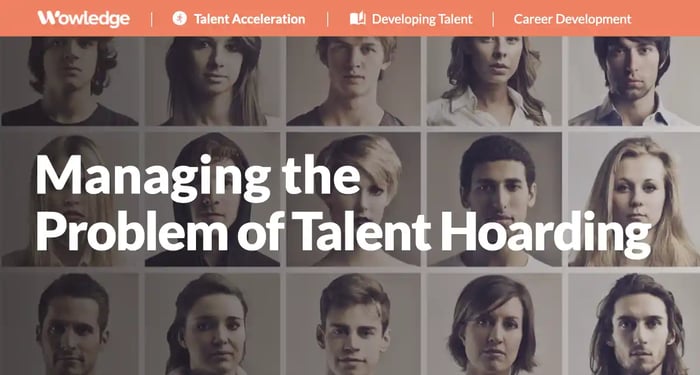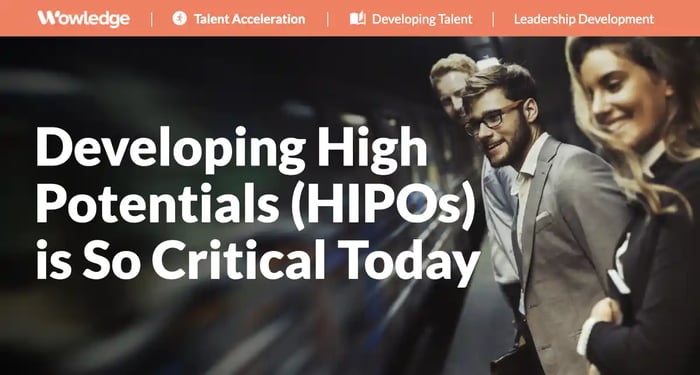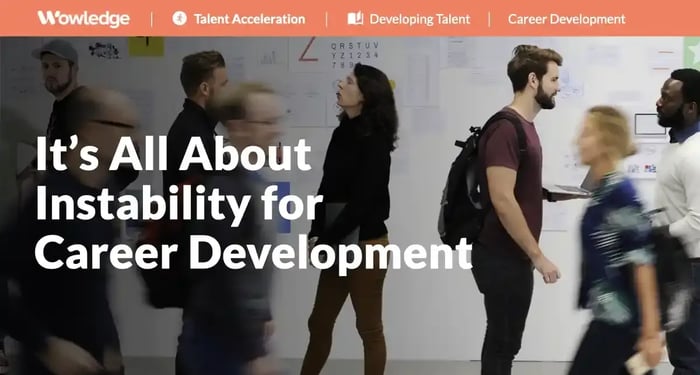Of all the reasons for an employee to leave an organization, lose motivation to perform at their best, and fail to remain engaged in delivering efforts supporting a company’s primary purpose and mission, the lack of attention to their career development and advancement is probably the stickiest. As humans, we seek opportunities to grow and be recognized for our contributions in visible and meaningful ways, the biggest ones often being those that are tangible and visible to others in our communities. The gains in social status and capital that we value (and are assigned by others) by a promotion, a significant transfer, or assignment to a prestigious strategic project team can be enormous. However, talent hoarding often denies employees such opportunities.
Unfortunately, an individual’s best efforts to outperform and stand out are too often quashed by their manager’s desire to maintain an intact team that can continue producing reliable results without interruption. In other words, high-performing individuals' ambitions for growth and advancement stand counter to their manager's needs and motivations. This is what talent hoarding is all about.
Talent hoarding is managers' tendency to restrict their workers' movement out of the department by limiting the visibility that other managers or functions can have to their skills, capabilities, performance, and potential. This often means that employees are artificially limited access to potential skill-developing and career-advancing opportunities ranging from nominations for high potential status, promotional opportunities, high-profile project participation, etc.
Sadly, evidence for this talent hoarding phenomenon abounds. Despite the superior (41% higher) employee retention experience of companies with high internal recruiting, 70% percent of talent acquisition professionals say that managers' desire to “hoard” their top performers is the primary obstacle to mobility. Similarly, 57% of HR and business leaders say it is easier to find a new job in a new company than in their current one.
While the ability for employees to move even laterally is two and a half times (2.5X) more predictive of employee retention than their level of compensation, the poor record of employee movement for both development and advancement persists. Given the apparent lack of progress on this front, how big of an issue is talent hoarding?
Reasons for talent hoarding
The scale of the problem appears to be universal, cutting across company size, locations, industries, and success measures of revenue, growth, profitability, and market share. Lateral mobility rates alone are reported to be only 8% per year, with only 25% of companies reporting theirs above 15%. Such a low level of annual transfers is depressingly low, even when adding in SHRM’s estimated 6% average promotion rate. That begs the question about the most common reasons for talent hoarding and the associated lack of internal movement across companies.
Managerial (mis)behavior
While many variables contribute to the issue, the largest driver of talent hoarding appears to involve the managers' preferences (and fears) of losing key talent and their subsequent ability to achieve their goals. For example, 50% of all companies and 74% of low-performing organizations acknowledge that talent hoarding by their managers is the biggest obstacle to successful employee mobility efforts. Other studies have shown that over 50% of managers admit to preventing their employees from pursuing new opportunities internally and that 46% of managers actively resist their employees leaving them for work that could broaden their skills and advance their careers.
Interesting perspectives on how managers either actively or passively resist their employees’ ambitions can serve as behaviors for HR and top leaders to watch out for, including:
- Limiting the opportunities for others to have visibility into their staff’s abilities and contributions
- Hesitancy to recommend top performers for special assignments or other jobs
- Act to convince the employee that they are not quite ready for a move or that it is not well-suited for them
- Rate their employees’ performance on a stricter “curve” consistently so they stay out of the limelight
- Limit training, development, and other growth opportunities
Lack of processes and tools
A significant concern lies with the apparent lack of resources that could be leveraged for planning and advancing employees' careers by both the managers who are open to/interested in helping them develop and advance and the employees themselves. Research has found that 49% of companies lack the necessary processes and tools to support the identification and movement of employees to other suitable roles inside their organizations. And 45% of those companies report that their employees lack visibility into growth, development, and movement opportunities.
One study found that 52% of high-performing companies provided employees and managers access to supporting technology (to post and apply for open internal jobs, project opportunities, skill requirements, etc.) versus only 31% of all other organizations. Only 30% of the high-performing companies (versus 21% of middle-to-lower performers) provided access to career path information. Managers' and employees' hands are tied without guidance and insights, making it easier to ignore the problem and practice talent hoarding.
Poor governance/ownership
A major barrier to employee mobility lies in the lack of a structured approach and ecosystem, both of which require discipline and oversight. Unfortunately, companies disagree on the most basic element of design, which is with whom the responsibility for career development and mobility lies – the manager or the employee. Two differing views exist: 1) the manager is better positioned to provide guidance given their higher levels of functional experience and tenure, and 2) it is the employee's responsibility because they know best where their interests and ambitions lie. One study highlighted the confusion when it asked people to choose all options that applied, found that 72% said it is the responsibility of the manager, 73% the employee, and 60% voted for HR.
Many HR functions contribute to the development and management of employee mobility - Talent Acquisition (for available openings and requirements), L&D (for training and development options aligned with different roles and job levels), Compensation (for position requirements, cross-organizational pay levels, and transfer pay policies), and HR Shared Services (transfer policies, relocation assistance, employee data/record updates, etc.). Other functions, such as those under the Administration umbrella (e.g., Facilities, Security, IT, Procurement), also have responsibilities, processes, and policies for employee mobility. These functions must work together to create and govern a responsive and sustainable process and ecosystem. Without associated executive oversight, it will likely languish and continue to represent a challenge.
Given that only 30% of organizations say they are effective at talent mobility, the lack of formal processes and tools that integrate the requirements of all the functions involved results in support for managers and employees that is often confusing, bureaucratic, and limiting. The effort it takes an individual manager to identify opportunities and guidance for 5-10+ direct reports in different roles and at different stages of their careers can be daunting and, frankly, easy to ignore and categorize as “too hard.”
Inattention to employee preferences
The lack of managerial support clearly disregards the ambitions and needs of their employees, as 73% of employees are interested in learning about new company roles. When those preferences are disregarded, employees have difficulty seeing the potential for advancement. They are shown to be almost three times (3X) less likely to show interest in lateral moves within the company. That leads to turnover, as 90% of workers who quit due to a lack of career development say they would have stayed if they had visibility to either lateral or promotional opportunities.
What happens when employees have the opportunity to overcome or bypass managerial behavior? During one organization's rotation of managers for their development, employees found a short-term opportunity to apply for other jobs without the constraint of the manager’s hoarding behaviors. They found a 123% increase in those employees' applications for promotional opportunities, suggesting that managers were actively preventing a large group of their subordinates from applying for opportunities. Talent hoarding is a clear example of ignoring employee's preferences and ambitions.
The benefits of talent mobility are clear
It has been demonstrated that when talent mobility is actively encouraged, promoted, and supported it drives positive and highly desirable talent outcomes. Those include:
Improved recruiting
When internal mobility is opened up as a recruiting capability, it has been shown that it takes only 4 applicants to result in a successful hire, versus job boards which require 36 candidates to result in one. Additionally, while companies spend only 6% of their total recruitment budget on internal candidates, they generate 14% of total hires.
Increased retention and engagement
Research by SHRM found that new hires who subsequently made a lateral job change were 62% more likely to stay, and those promoted in their first three years were 70% more likely to extend their tenure. In fact, employees working in high-mobility organizations have double (2X) the tenure of peers working in low-mobility environments.
Internal promotes deliver faster and better than external hires. Newly hired employees are 61% more likely to be fired or laid off than employees who are transferred or promoted and 21% more likely to quit. Furthermore, those hired externally were found to take three (3) years longer to perform at the same level as their peers who were internal transfers/promotes.
A mark of high-performing organizations
The most successful companies are two times (2X) as likely to encourage and promote internal movement within their organizations. They are also twice (2X) as likely to prioritize mobility over lower-performing companies, with 30% pointing to employee retention as a key reason.
A practice common to many high-performing managers
Having a reputation as a manager who actively encourages, develops, and promotes the development and careers of their employees has been shown to both separate good from great, and generate significant future staffing benefits. For example, one study demonstrated that managers who promote their staff members at a higher rate than their peers experienced an 8.9% increase in internal applications during the following year and an 11.6% increase in transfer applications from top performers.

Solutions for the talent hoarding problem
The challenges can appear overwhelming, given the need to create consistency and wrangle hundreds or thousands of managers, the range of people and functions involved in the process, the ongoing and highly personalized nature of suitability and development for each role, and the fact that this touches every employee in the organization. Avoiding and dismantling the talent hoarding and the efforts of these career blockers takes a thoughtful and comprehensive approach to creating effective and sustainable processes and resources for a robust mobility ecosystem. The goal should be to create an environment that supports managers and employees in managing career moves that best fit the individual and meet the long-term talent requirements of the organization. Key strategies and tactics include:
1. Articulate a strategy
Bring together a cross-functional project team of experts to devise a clear mission/purpose statement, outcome objectives, best practice and technology options, and a business case that includes budget and investments. Articulate a governance strategy that establishes process ownership, executive oversight, and the roles and responsibilities of all involved parties. Develop a strategy with a timeline for implementation, investments, and policies that support and enable talent mobility. Remember to create a change management plan and outcome measurement KPIs to create an environment of accountability and trust.
2. Create formal processes
Develop a formal and structured process for managers to discuss each of their employees in joint (facilitated) sessions to review their strengths, development needs, and ambitions. Share open slots/opportunities and expected movement within each department, and the requirements that can be met by other employees. These "talent calibration” sessions should help identify internal opportunities for employees to grow.
In addition, create “development days” where formal discussions can be held with each employee and either their manager or a mobility expert to plan potential moves and learning and development resources, programs, and people (e.g., mentors, coaches) who can support their desired growth and career pathways.
3. Enable internal recruiting
Within the bounds of reasonable policy and practice standards, such as requiring minimum tenures in each role before application to other roles is allowed, provide access for the talent acquisition (TA) and workforce planning teams to employee profiles for open position consideration. Set priorities and goals for the TA team members to establish a manageable process that identifies hidden talent while ensuring that no departments are consistently or regularly “raided” for talent needed elsewhere. Create an environment where employees are considered “corporate-wide assets” and can thus be proactively moved into new roles to best meet the organization's business needs with the support and blessing of top leadership.
4. Train, track, and hold managers accountable
Provide leaders and managers with training on the development and mobility processes, expected behaviors, and available resources they can use to support their direct reports. Provide them with online access to career paths and lattices showing historical movement and skills overlaps that together can make identifying interesting career options visible to the manager and employee. Install performance metrics and make employee development and mobility/promotion goals for each manager in their annual performance management process. Consider removing managers who cannot adapt to an upgraded mobility vision and include such perspectives and capabilities in promotion decisions.
Create a management culture recognizing and rewarding “net talent exporters” who regularly generate candidates for promotional or cross-departmental/functional roles. Research by i4cp suggests that only 12% of companies reward managers for being net exporters.
5. Create skills-based assessments
Adopt a skills-based approach to talent management where employees submit annual updates to a standard online profile that tracks both their skills and the associated skills into a common talent database. Formal, validated assessments for technical/functional skills, leadership potential, etc. offer a powerful window and bias-reducing capability.
Skills data repositories can be used to search for combinations of skills, the presence (or shortage) of currently needed and emerging skills, and support identifying employees with transferrable skills. While only 10% of organizations currently have an employee skills database or inventory with employee profiles, the value they bring to the workforce/L&D/strategic HR planning processes cannot be overstated.
6. Leverage technology to support and enable mobility
By placing the visibility and resources into the hands of employees, the potential to weaken manager’s grip and hoarding of talent becomes substantial. Its mere presence and availability imply support for employee movement by top leadership, and such platforms put more power of information and insight into the hands of the employees.
In addition, employees are 80% more likely to prefer technology over direct, initial conversations with their managers, perhaps out of convenience or a desire not to tell their manager before researching potential options. These technologies often leverage AI to facilitate skill matching and make recommendations for learning options, project opportunities, career paths, and other employees who could serve as mentors or insight providers.
Relevant Practices & Tools
Creating a Culture of Internal Mobility that Supports Employee Development and Retention. >
Creating a culture of mobility requires management to accept that the benefits of movement (promotions and transfers) far outweigh the costs of replacing workers in their teams... more »
Defining Career Lattices to Define Robust Lateral and Vertical Mobility. >
The ability to enable the movement of employees proactively and strategically from role to role at the leadership, professional, and operational levels is a key flexibility... more »
Leveraging Career Development Technologies and Resources for Enhanced Opportunity Identification. >
Current technologies offer the promise of tremendous efficiencies in the development and handling of career development processes and insights... more »
Talent Marketplace Explainer: Mastering the Fundamentals. >
A Talent Marketplace is a technology platform that connects workers with opportunities internally within organizations and can consider external candidates... more »
The Stakeholder Analysis Template: Identify the Individuals Needed for Successful Change and Their Level of Support. >
This template and process help organizations discover what stakeholders need and expect from a change initiative... more »
About Wowledge
Wowledge is the expert-driven platform for lean teams building strategic HR programs. Members enjoy access to up-to-date best practices, step-by-step guides, tools, templates, and insights to accelerate the design and implementation of all key HR programs and processes.
Since each organization has unique characteristics, needs, and aspirations, Wowledge's practices are developed utilizing an exclusive stage-based approach – from Core to Advanced to Emerging – that reflects distinct levels of sophistication to meet our members where they are.
Build strategic HR programs with refreshingly easy-to-follow best practices.
Get started for FREE! Learn more.










